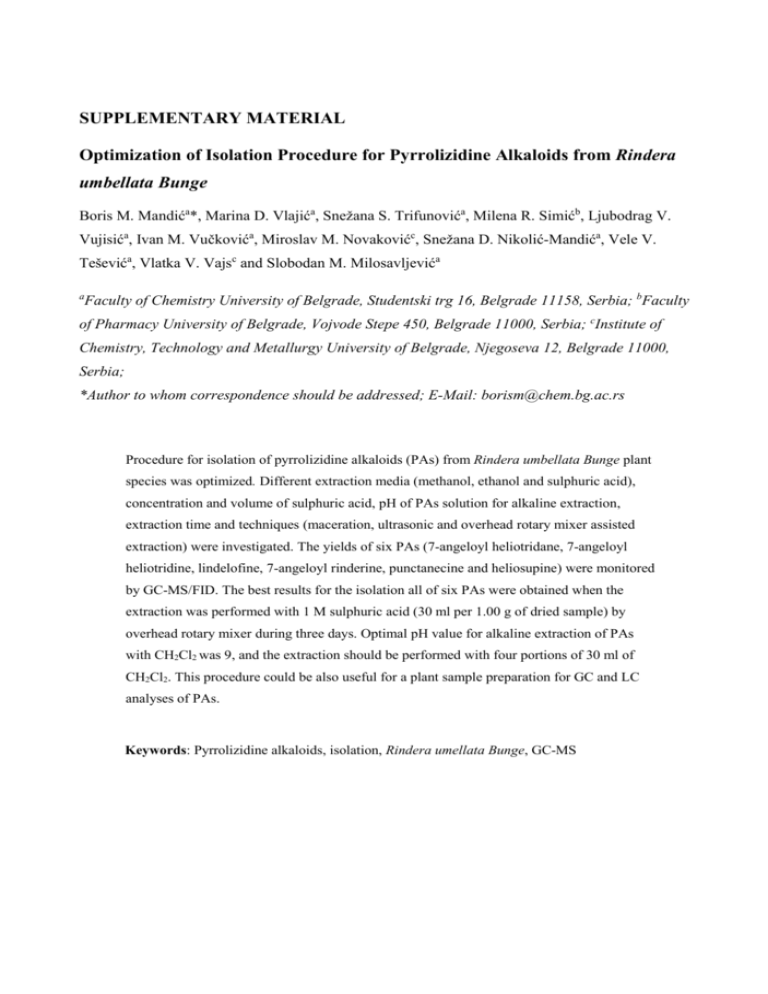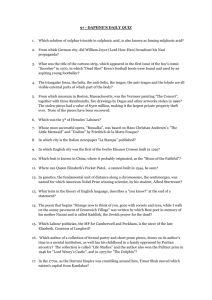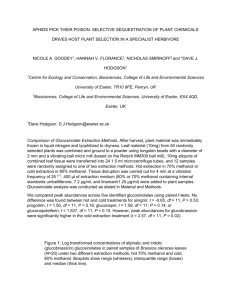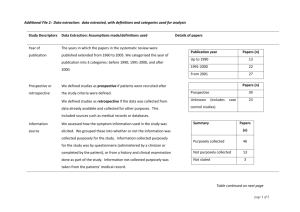Plant Material
advertisement

SUPPLEMENTARY MATERIAL Optimization of Isolation Procedure for Pyrrolizidine Alkaloids from Rindera umbellata Bunge Boris M. Mandića*, Marina D. Vlajića, Snežana S. Trifunovića, Milena R. Simićb, Ljubodrag V. Vujisića, Ivan M. Vučkovića, Miroslav M. Novakovićc, Snežana D. Nikolić-Mandića, Vele V. Teševića, Vlatka V. Vajsc and Slobodan M. Milosavljevića a Faculty of Chemistry University of Belgrade, Studentski trg 16, Belgrade 11158, Serbia; bFaculty of Pharmacy University of Belgrade, Vojvode Stepe 450, Belgrade 11000, Serbia; cInstitute of Chemistry, Technology and Metallurgy University of Belgrade, Njegoseva 12, Belgrade 11000, Serbia; *Author to whom correspondence should be addressed; E-Mail: borism@chem.bg.ac.rs Procedure for isolation of pyrrolizidine alkaloids (PAs) from Rindera umbellata Bunge plant species was optimized. Different extraction media (methanol, ethanol and sulphuric acid), concentration and volume of sulphuric acid, pH of PAs solution for alkaline extraction, extraction time and techniques (maceration, ultrasonic and overhead rotary mixer assisted extraction) were investigated. The yields of six PAs (7-angeloyl heliotridane, 7-angeloyl heliotridine, lindelofine, 7-angeloyl rinderine, punctanecine and heliosupine) were monitored by GC-MS/FID. The best results for the isolation all of six PAs were obtained when the extraction was performed with 1 M sulphuric acid (30 ml per 1.00 g of dried sample) by overhead rotary mixer during three days. Optimal pH value for alkaline extraction of PAs with CH2Cl2 was 9, and the extraction should be performed with four portions of 30 ml of CH2Cl2. This procedure could be also useful for a plant sample preparation for GC and LC analyses of PAs. Keywords: Pyrrolizidine alkaloids, isolation, Rindera umellata Bunge, GC-MS Experimental Section General An overhead mixer Reax 20/8 (Carl Roth, Germany) rotary mixer and a Transsonic T 760 DH (Elma, Germany) ultrasonic bath with an ultrasonic frequency of 40 kHz and an effective ultrasound power of 170 W were employed for the extractions. Pentacosan standard was obtained from Sigma (USA). Sulfuric acid and ammonium hydroxide were of analytical grade and were purchased from Zorka (Serbia). Methanol and ethanol were purified by distillation before use. Plant Material The whole plants of Rindera umbellata were collected during the flowering period in Deliblatska peščara, Serbia (June 2011.). Harvest was performed at Latitude N 44°57'58'' and Longitude E 21°1'48''. Voucher specimen is deposited in the Herbarium of the Faculty of Biology, University of Belgrade. Voucher specimen number is BEOU 17070. Sample preparation – general procedure The plant material of R. umbellata was air-dried in shadow at room temperature for 15 days. It was powdered by blending and homogenized before each set of experiments. Measured mass of each sample was 1.00 g. From samples, PAs were extracted with methanol, ethanol and sulphuric acid, using various extraction techniques (maceration at room temperature, ultrasonic assisted extraction and overhead rotary mixer assisted extraction). The methanol and ethanol extracts were evaporated under reduced pressure and dry residues were dissolved in solution of 1 M sulphuric acid. Acid aqueous solutions were further extracted with CH2Cl2 (2×30 mL) to remove neutral compounds. The aqueous layers were then made alkaline (pH 9.0) with ammonium hydroxide and extracted with CH2Cl2 (3×30 mL). After removal of CH2Cl2 by evaporation on reduced pressure, 10 μL of pentacosan solution in CH2Cl2 (C=1.3550 g/L) was added to PAs mixture. Mixture was dissolved in 1.00 ml of CH2Cl2 and analysed by GCMS/FID. All experiments were performed in triplicate. Methanol and ethanol maceration Samples of plant material were extracted with methanol (30ml) for 1, 2, 3, 4 and 5 days and ethanol (30 ml) for four days at room temperature and dark place. After filtration and solvent removal, the residue of each sample was dissolved in 1 M sulphuric acid and further treated as it described above (see subsection Sample preparation – general procedure). Sulphuric acid maceration Samples were extracted with 1 M sulphuric acid (30 ml) for 1, 2, 3, 4 and 5 days at dark place and room temperature. After filtration, the mixture was extracted with CH2Cl2 (2×30 mL). Further treatment was the same as for methanol and ethanol maceration. Sulphuric acid - a concentration optimization Samples were treated as described in subsection Sulphuric acid maceration for four days, only different concentrations of sulphuric acid were used: 0.05 M, 0.1 M, 0.25 M, 0.5 M, 0.75 M, 1 M, 1.25 M and 1.5 M. Sulphuric acid - extraction time and extraction techniques optimization Samples of the plant material were extracted with 1 M sulphuric acid (30 ml) for 1, 2, 3, 4 and 5 days at room temperature by different extraction techniques: maceration on dark place, ultrasonic bath and overhead rotary mixer extractions. After filtration, the mixture was extracted with CH2Cl2 and further treated as it described above (see subsection Sample preparation – general procedure). Sulphuric acid - volume optimization Samples were extracted with 1 M sulphuric acid for three days by overhead rotary mixer with different volumes of sulphuric acid: 25 ml, 30 ml, 35 ml, 40 ml, 45 ml and 50 ml. After filtration, the mixture was treated as it described in section Sample preparation – general procedure. pH of alkaline extraction Plant samples were extracted with 1 M sulphuric acid (30 ml) for three days by overhead rotary mixer. After filtration, the mixture was extracted with CH2Cl2 (2 × 30 mL). The aqueous layer of each sample was then made alkaline with ammonium hydroxide to different pH value: 7.5, 8, 8.5, 8.75, 9, 9.25, 9.5, 9.75, 10 and 10.5. Alkaline solution was extracted with CH2Cl2 and further treated as it described above (see subsection Sample preparation – general procedure). Number of alkaline re-extractions Samples were extracted with 1 M sulphuric acid (30 ml) for three days by overhead rotary mixer. After filtration, the mixture was extracted with CH2Cl2. The aqueous layer was then made alkaline (pH 9) with ammonium hydroxide. Alkaline solution was re-extracted with CH2Cl2: 1, 2, 3, 4 and 5 times, and PAs were analysed. GC-MS/FID analyses GC-MS analyses were performed on an Agilent 7890A GC system equipped with a 5975C inert XL EI/CI MSD and a FID detector connected by capillary flow technology through a 2way splitter with make-up gas. An HP-5 MS capillary column (Agilent Technologies, Santa Clara, CA, USA, 25 mm i.d., 30 m length, 0.25 μm film thickness) was used. Samples were injected in split less mode. The injection volume was 0,2 μL, 1 μL, and 3 μL the injector temperature was 250°C. The carrier gas (He) flow rate was 1.1 mL/min, whereas the column temperature was programmed linearly in a range of 100 325 °C at a rate of 10 °C/min. The transfer line temperature was 320 °C. The FID detector temperature was 300 °C. EI mass spectra (70 eV) were acquired in m/z range of 45–450, and the ion source temperature was 230 °C. Yield of PAs Before GS-MS/FID analyses, pentacosan as inert standard was added in every sample of isolated PAs mixture. Yield of each PA was calculated from GC chromatogram, as follows: 𝑌𝑖𝑒𝑙𝑑 𝑜𝑓 𝑃𝐴 = 𝑃𝑒𝑎𝑘 𝑎𝑟𝑒𝑎 𝑜𝑓 𝑃𝐴⁄𝑃𝑒𝑎𝑘 𝑎𝑟𝑒𝑎 𝑜𝑓 𝑖𝑛𝑒𝑟𝑡 𝑠𝑡𝑎𝑛𝑑𝑎𝑟𝑑 (1) Experiments were performed in triplicate (n=3). RSD for mean values of PAs yields were in the range of 0.81-29.74 %. Figures: Figure S1. Structures of monitored PAs from R. umbellata (1 - 6). Figure S2. Yields of PAs in relation to days of maceration in the methanol. Figure S3. Yields of PAs extracted with methanol, ethanol and sulphuric acid during four days at dark place and room temperature. Figure S4. Yields of PAs (1-6) in relation to molarity of sulphuric acid used for their extraction. Figure S5. Yields of PAs (1-6) in relation to days of maceration with 1 M sulphuric acid, at room temperature. Figure S6. Yields of PAs (1-6) in relation to days of ultrasonic assisted extraction with 1 M sulphuric acid. Figure S7. Yields of PAs (1-6) in relation to days of extraction with 1 M sulphuric acid by overhead rotary mixer. Figure S8. Comparison of yields of PAs (1-6) accomplished after four days of maceration, three days of extraction by ultrasonic bath and overhead rotary mixer assisted extractions of plant material with 1M sulphuric acid. Figure S9. Yields of PAs (1-6) isolated from 1.00 g of the plant material (with 1M sulphuric acid during the extraction by overhead rotary mixer for three days) in relation to the volume (ml) of sulphuric acid. Figure S10. Yields of isolated PAs (1-6) in relation to pH values of aqueous solutions for alkaline extraction of PAs with CH2Cl2. Figure S11. Yields of isolated PAs in relation to the number of continuous alkaline reextractions with CH2Cl2 at pH 9.







